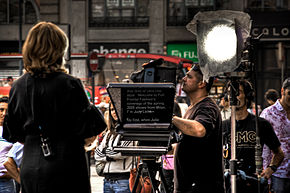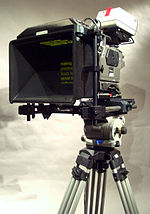Teleprompter: Difference between revisions
| Line 22: | Line 22: | ||
In the late 1990s and early 2000s, Autoscript (a UK- and US-based company) pioneered use of [[Thin film transistor liquid crystal display|TFT-LCD]] monitors, rather than the traditional [[Cathode ray tube|CRT]]s. This enabled significantly less weight on the camera and improved portability. They also introduced high-brightness monitors, enabling prompters to be used in direct sunlight. A further breakthrough in 2005 introduced Voice Activated Prompting. Along with their partner, Sysmedia, Autoscript developed a prompter that required no peripheral to control the scroll of the prompter. The voice-activated prompter simply scrolled at the speed of the presenter's speech. |
In the late 1990s and early 2000s, Autoscript (a UK- and US-based company) pioneered use of [[Thin film transistor liquid crystal display|TFT-LCD]] monitors, rather than the traditional [[Cathode ray tube|CRT]]s. This enabled significantly less weight on the camera and improved portability. They also introduced high-brightness monitors, enabling prompters to be used in direct sunlight. A further breakthrough in 2005 introduced Voice Activated Prompting. Along with their partner, Sysmedia, Autoscript developed a prompter that required no peripheral to control the scroll of the prompter. The voice-activated prompter simply scrolled at the speed of the presenter's speech. |
||
Although renowned for his oratory, President [[Barack Obama]] was widely ridiculed in early 2009 for his reliance on a teleprompter and his gaffe-prone performances when parted from his 'prompter.<ref name=bg>{{cite news |first=John|last=McCormick|title= Obama's 'Tonight Show' gaffe one of many for president|url=http://www.chicagotribune.com/news/local/chi-obama-gaffe-21-mar21,0,6938805.story|work= [[Chicago Tribune]]|date=2009-03-21 |accessdate=2009-03-21}}</ref> One satire took the form of a blog "written" by Obama's presidential teleprompter.<ref>[http://baracksteleprompter.blogspot.com Barack Obama's Teleprompter's Blog].</ref> |
|||
==Etymology== |
==Etymology== |
||
Revision as of 23:16, 21 March 2009

| (1) Video camera | (2) Shroud |
| (3) Video monitor | (4) Two-way mirror |
| (5) Image from subject | (6) Image from video monitor |

This article needs additional citations for verification. (March 2009) |
A teleprompter (also known as an autocue) is a display device that prompts the person speaking with an electronic visual text of a speech or script. Using a teleprompter is similar to the practice of using cue cards. The screen is in front of the lens of the camera, and the words on the screen are reflected to the eyes of the speaker using a two-way mirror.
(Note that this is only true in principle — when the space between the lens and the mirror is covered in a shroud, an ordinary glass pane will work as a two-way mirror).
As the speaker does not need to look down to consult written notes, he appears to have memorized the speech or be speaking spontaneously, and will look directly into the camera lens. Cue cards, on the other hand, will always be placed away from the lens axis, making the speaker look at a point beside the camera, which leaves a "distracted" impression.
History
The first "teleprompters" were simply mechanical devices located near the camera. The script was printed on a paper scroll, which was advanced as the performer read.
The TelePrompTer company was founded in the 1950s by Fred Barton, Jr., Hubert J. (Hub) Schlafly, and Irving Berlin Kahn. Barton was an actor who suggested the concept of the teleprompter as a means of assisting television performers who had to memorize large amounts of material in a short time.
The first personal computer–based Teleprompter, Compu=Prompt, appeared in 1982. It was invented and marketed by Courtney M. Goodin and Laurence B. Abrams in Hollywood, California. The custom software and specially-redesigned camera hardware ran on the Atari 800 Personal Computer. Their company later became ProPrompt, Inc., which is still providing teleprompting services over 25 years later. Other paper-based Teleprompting companies — Q-TV and Telescript — followed suit and developed their own software several years later, when computers with enough graphics power to provide the smooth scrolling text became available.
Jess Oppenheimer, producer of I Love Lucy, claims credit for the original concept of the teleprompter and was awarded the U.S. patent for its creation.[1] Originally used so that Lucille Ball could read commercials on-camera, it soon became a staple for television news.
As late as 1992, The Tonight Show Starring Johnny Carson was still using an early mechanical teleprompter.
In the late 1990s and early 2000s, Autoscript (a UK- and US-based company) pioneered use of TFT-LCD monitors, rather than the traditional CRTs. This enabled significantly less weight on the camera and improved portability. They also introduced high-brightness monitors, enabling prompters to be used in direct sunlight. A further breakthrough in 2005 introduced Voice Activated Prompting. Along with their partner, Sysmedia, Autoscript developed a prompter that required no peripheral to control the scroll of the prompter. The voice-activated prompter simply scrolled at the speed of the presenter's speech.
Etymology
The word TelePrompTer, with internal capitalization, originated as a trade name used by the TelePrompTer Company, who first developed the electronic device in the 1950s.
The word teleprompter, with no capitalization, had become a genericized trademark, because it is used to refer to similar systems manufactured by many different companies. The United States Patent Office does not have any "live" trademarks registered for the word "teleprompter," but this does not rule out the possibility of a company enforcing the trademark without registering it. Some other common generic terms for this type of device include:
- electronic speech notes
- cueing device
- idiot board (slang)
- prompter
- autocue (in certain Commonwealth countries)
Modern design
Television

Modern teleprompters for news programs consist of a personal computer, connected to video monitors on each camera. The monitors are often black-and-white monochrome and have the horizontal scanning reversed to compensate for the reflection of the mirror. A peripheral device attached to the serial port has a knob that can be turned to speed up, slow down, or even reverse the scrolling of the text. The text is usually displayed in white capital letters on a black background for the best readability, while cues are in inverse video (black on white). Difficult words (mainly foreign names) are spelled out phonetically, as are other particulars like "Nine-eleven" (to specify that the event 9/11 should not be pronounced "nine-one-one," for example).
Speeches

Teleprompters are often used for speeches as well. In this application, they are called Conference Teleprompter Systems. In this case, the reflector is usually a piece of glass with a special partially reflective coating. It is mostly transparent so as to not block the view of the speaker by the audience or cameras. Usually, two of these are set up, one on either side of the lectern (if there is one), so that the speaker can look around at the audience and always be able to see one. Except for these aesthetic changes, they work in the same way as they do for television.
With the development of small, cheap teleprompter software applications, many different disciplines are now using simple desktop applications to help them deliver sermons, deliver speeches, and create quality audios. Unlike their big brothers, these small applications work on a desktop or laptop computer, enabling the speaker to control the rate and flow of his speech. They are also used by many different organizations and schools to deliver prewritten information by relative novices. They are usually called "personal teleprompters."
Concerts
Teleprompters are sometimes used in concerts, to assist performers who have trouble remembering the words to songs. The teleprompter may be of the kind used in speeches, or it may be only a monitor that is set into the stage floor.
Interrotron
Documentary filmmaker Errol Morris uses a teleprompter-like setup in conducting interviews which he refers to as the "Interrotron." The prompter equipment is set up on the camera (often a film camera); however, instead of displaying a written script, it is used to display the image coming from a video camera trained on Morris who is seated nearby. In this way, the interview subject can be looking directly into the lens of the camera to see Morris' face while speaking, instead of off in some other direction. The camera focused on Morris can also be set up with a prompter displaying the subject (using the "video assist" output if a film camera is used on the subject). In this way, the two people can carry out a virtual face-to-face conversation for the interview.
Notes
- ^ US 2883902, see also US 2926559.
